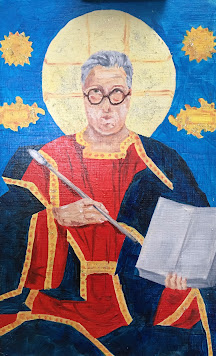One of my briefs at Art School this term:
‘Produce a body of work that includes at least one resolved oil painting on prepared board or canvas, or another appropriate surface. The painting must reflect ideas relating to positive and negative and deal with the subject matter of self-portraiture’.
It came to me in a flash, make an icon of me!
 |
My icon |
Saint Luke created the first icon, one of the Virgin Mary. On being presented with it she is alleged to have said “may the grace of him who was born of me, through me, being imparted to this icon”.
The Byzantine church encouraged their creation. If you were studying a particular Saint having an Icon of that Saint in front of you was seen as a study aid.
Their creation and development spread across the Western Church. Icons in the Byzantine style were found it all Christian countries. However their importance was eroded with development of Italian Renaissance art in the 15th and 16th centuries. Today they are revered once more, following revivals in the eastern church. Important centres for their creation are Crete, Greece and Serbia.
 |
Outside a church in Moscow |
Icons are small wooden panels usually about a five size so 21 x 50 cm. They are painted using egg tempera on gessothe ground. The combination of these two materials accounts for their longevity, egg tempera is egg yolk mixed with powder colour.
Interestingly the process of creating an icon is called ‘writing’ an icon and those who create are called icon writers. This is because the Greek word for painting and writing is one of the same ‘graphos’.












